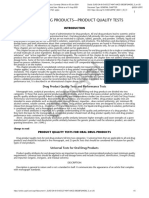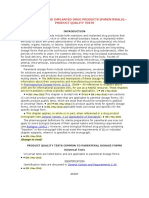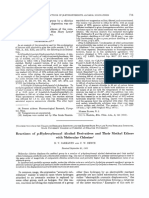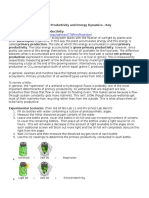2 PDF
2 PDF
Uploaded by
pramothCopyright:
Available Formats
2 PDF
2 PDF
Uploaded by
pramothOriginal Title
Copyright
Available Formats
Share this document
Did you find this document useful?
Is this content inappropriate?
Copyright:
Available Formats
2 PDF
2 PDF
Uploaded by
pramothCopyright:
Available Formats
Accessed from 10.6.1.
1 by belmont7 on Thu Nov 10 02:18:14 EST 2016
74 á2ñ Oral Drug Products—Product Quality Tests / General Requirements USP 40
á2ñ ORAL DRUG PRODUCTS—PRODUCT QUALITY TESTS
INTRODUCTION
Oral delivery is the most common route of administration for drug products. All oral drug products lead to systemic and/or
local action in the oral cavity and/or gastrointestinal tract. Oral drug products fall primarily into two main categories: solids
and liquids. Solid oral drug products include but are not restricted to capsules, tablets, granules, and powders. Similarly, liquid
oral drug products include but are not restricted to solutions, suspensions, and emulsions. The definitions and descriptions of
these dosage forms and brief information about their composition and manufacturing process are found in Pharmaceutical
Dosage Forms á1151ñ. [NOTE—All references to chapters above á1000ñ are for informational purposes only, for use as a helpful
resource. These chapters are not mandatory unless explicitly called out for application.]
This chapter focuses on the product quality tests that are generally necessary for oral drug products for a single or combina-
tion of small molecules of active ingredients. Biologics in solid dosage forms are not considered. In this chapter, the terms
“drug substance” and “active ingredient” are used interchangeably. The contents of this chapter do not necessarily apply to
drug products that are intended for use other than by oral administration. For example, the chapter does not address oromu-
cosal dosage forms. Some of the tests indicated in this chapter may be performed on an in-process basis or omitted as routine
tests based on process validation. However, the product must meet USP compendial requirements when sampled and tested,
once the product is on the market.
This chapter provides lists of consolidated common product quality test requirements in a concise and coherent fashion. This
General Chapters
chapter applies, in part or whole, when referenced in a drug product monograph (see General Notices, 3.10 Applicability of
Standards). This chapter includes the quality tests for the specific route of administration. The quality tests listed can be used as
appropriate by manufacturers toward the development of new drug product monographs for submission to USP. If a validated
performance test procedure is available for the specific drug product, it is identified in a general chapter below á1000ñ. In cases
where a validated procedure cannot be recommended, but if the information is available for a product quality and/or product
performance test, it is described in an informational chapter above á1000ñ.
Drug Product Quality Tests and Performance Tests
Monograph tests, analytical procedures, and acceptance criteria for testing oral drug products are divided into two catego-
ries: 1) those that assess general product quality attributes, and 2) those that assess product performance, which is a specific
quality attribute typically linked to bioavailability and bioequivalence studies (see Assessment of Drug Product Performance—Bio-
availability, Bioequivalence, and Dissolution á1090ñ). Drug product quality tests are intended to assess attributes such as identifi-
cation, strength (assay), impurities (universal tests), dose content uniformity, pH, minimum fill, alcohol content, volatile con-
tent, and microbial content (specific tests). Drug product performance tests are designed to assess in vitro drug release from
dosage forms (e.g., Dissolution á711ñ and Drug Release á724ñ). For liquid oral drug products in solution, performance is consid-
ered optimal, and a monograph performance test is not included.
Each of these attributes is important for a primary understanding of the quality and performance of a drug product. Thus,
they form the basis for the monograph. A compendial product should meet all drug product quality tests and drug product
performance tests contained in its monograph.
[NOTE—Dissolution tests, specifically dissolution profile similarity between higher strengths and lower strengths of a given
manufacturer’s product and dissolution profile similarity between the generic product and the reference product, are used for
granting biowaivers. See á1090ñ.]
PRODUCT QUALITY TESTS FOR ORAL DRUG PRODUCTS
Drug product quality tests for oral drug products fall into two categories: 1) universal tests that are applicable to all oral drug
products and should be included in the monograph, and 2) specific tests that should be considered for inclusion for specific
types of oral products.
Universal Tests for Oral Drug Products
Product quality attributes for oral dosage forms are important to ensure that commercialized products meet minimum quali-
ty requirements. Universal tests should be applied to all oral dosage forms and include Description, Identification, Strength (As-
say test), and Impurities (organic, inorganic, and residual solvents).
DESCRIPTION
Description is general in nature and is not a standard in itself. It communicates the appearance of an article that complies
with monograph standards.
Official from May 1, 2017
Copyright (c) 2016 The United States Pharmacopeial Convention. All rights reserved.
Accessed from 10.6.1.1 by belmont7 on Thu Nov 10 02:18:14 EST 2016
USP 40 General Requirements / á2ñ Oral Drug Products—Product Quality Tests 75
IDENTIFICATION
The identification test is defined in General Notices, 5.40 Identity. It is included in a monograph as an aid to confirm that the
article contains the labeled drug substance by providing a positive identification of the drug substance or substances in a drug
product.
One method of confirming the identity is to compare the retention time of the sample with that obtained for the standard
injections in a chromatographic assay procedure. Other methods often used to orthogonally confirm the identity of the active
ingredient are: Thin-Layer Chromatographic Identification Test á201ñ, Spectrophotometric Identification Tests á197ñ, Nuclear Mag-
netic Resonance Spectroscopy á761ñ, Near-Infrared Spectroscopy á1119ñ, and Raman Spectroscopy á1120ñ, among others. The ana-
lytical procedure must be able to distinguish the active ingredient from all excipients that are present or from potential degra-
dation products likely to be present. Care must also be taken to ensure that the chromatographic system separates the article
from other closely related drug substances, impurities, and additives. Infrared and ultraviolet absorption also can be used for
identification (see á197ñ), if the procedure has been demonstrated to be selective for the drug substance via an appropriate
validation or verification study. The results of the identification test must be compared to the results obtained from a similarly
prepared, suitable Reference Standard.
ASSAY
The assay is a specific and stability-indicating test to determine the potency (content) of the drug product. When a nonspe-
cific assay (e.g., titration) is justified, other supporting analytical procedures should ensure that any interfering species can be
General Chapters
detected. In general the a priori acceptance of ±10% variation in limits of a quality attribute (e.g., assay) from the target label
claim (100%) in most cases is intended to account for manufacturing variability and shelf-life stability and is primarily based on
the notion that such variation in a quality attribute is less likely to have any noticeable adverse impact on the desired clinical
outcome. Acceptance criteria of 95.0%–105.0% are used with justification (e.g., for drug products with narrow therapeutic
index). Activity assays and absolute content assays also are acceptable when justified.
IMPURITIES
Process impurities, synthetic by-products, and other inorganic and organic impurities may be present in the drug substance
and in the excipients used in the manufacture of the drug product. These impurities are limited by drug substance and exci-
pient monographs. During product manufacture and over the shelf life of the product, degradation products can form. These
can be a result of degradation of the drug substance or from interactions between the drug substance and excipient(s),
among other factors. The procedures and acceptance criteria should specifically limit toxic materials. See specific requirements
in the General Notices 5.60, Impurities and Foreign Substances. [NOTE—For additional information, see Impurities in Drug Sub-
stances and Drug Products á1086ñ.]
Specific Tests for Tablets
In addition to the Universal Tests for Oral Drug Products described above, the following specific tests for tablets should be
considered, depending upon the nature of the drug substance and formulation.
VOLATILE CONTENT
The test and the specific method depend on the nature of the article. Special consideration should be given to dosage forms
for which water content has been shown to be a potential quality attribute and to products where solvent is used in the manu-
facture of the drug product.
When the presence of moisture or other volatile material may become critical, analysts must determine the amount of un-
bound volatile solvents or volatile matter of any kind that is driven off by Loss on Drying á731ñ or another suitable technique
(e.g., water activity). For substances that appear to contain water as the only volatile constituent, the procedure given in Water
Determination á921ñ may be appropriate. For drug products, analysts also should consult Residual Solvents á467ñ.
DISINTEGRATION
Disintegration is an essential attribute of oral solids, except for those intended to be chewed before being swallowed and for
delayed- or extended-release products. This test measures the time it takes for the dosage unit to disintegrate in an aqueous
medium and is described in detail in Disintegration á701ñ. For certain dosage forms (e.g., effervescent tablets, disintegrating
tablets, and others) the European Pharmacopoeia describes the disintegration test in great detail. The disintegration test for
some of the dosage forms in this chapter is included for completeness. For detailed procedures, please refer to á701ñ or the
European Pharmacopoeia. The disintegration test, if included, is used only as a quality control test and not as a product per-
formance test and should conform with the specifications in the monograph. Only when disintegration has been correlated
Official from May 1, 2017
Copyright (c) 2016 The United States Pharmacopeial Convention. All rights reserved.
Accessed from 10.6.1.1 by belmont7 on Thu Nov 10 02:18:14 EST 2016
76 á2ñ Oral Drug Products—Product Quality Tests / General Requirements USP 40
with dissolution of a dosage form can a disintegration test be used as a product performance test (ICH Guidance Q6A, availa-
ble at www.ich.org). In all other instances, a dissolution test should be considered as a product performance test.
TABLET FRIABILITY
The test procedure is applicable to most compressed, uncoated tablets. Friability determines the ability of tablets to with-
stand mechanical stresses and their resistance to chipping and surface abrasion. [NOTE—For additional information, see Tablet
Friability á1216ñ.]
TABLET BREAKING FORCE
Tablet breaking force measures the mechanical integrity of tablets, which is the force required to cause them to fail (i.e.,
break) in a specific plane. [NOTE—For additional information, see Tablet Breaking Force á1217ñ.]
UNIFORMITY OF DOSAGE UNITS
Uniformity of dosage units must be demonstrated by either content uniformity or weight variation. Content uniformity is
based on the assay of the individual content of drug substance(s) in a number of dosage units to determine whether the indi-
vidual contents are sufficiently close to label claim. Weight variation can be used as an alternative to estimate content uniform-
ity under certain conditions (see Uniformity of Dosage Units á905ñ).
General Chapters
Specific Tests for Uncoated Tablets
Uncoated tablets include single-layer tablets that result from a single compression of particles and multilayer tablets that
consist of concentric or parallel layers obtained by successive compression of particles of different composition. The excipients
used generally are not specifically intended to modify the release of the active substance in the digestive fluids. Uncoated tab-
lets include but are not limited to: effervescent tablets, buccal tablets, sublingual tablets, chewable tablets, disintegrating tab-
lets, orally disintegrating tablets, tablets for oral solution, and tablets for oral suspension. For uncoated tablets, disintegration
should be tested as directed in á701ñ.
BUCCAL, SUBLINGUAL, AND ORALLY DISINTEGRATING TABLETS
These dosage forms are discussed in Mucosal Drug Products—Product Quality Tests á4ñ. They are listed here for informational
purposes and completeness.
CHEWABLE TABLETS
Chewable tablets are not required to comply with the disintegration test. Chewable tablets (intact) should undergo dissolu-
tion testing, as a product performance test (if cited in the monograph), because they might be swallowed without proper
chewing by a patient. In general, the dissolution test conditions for chewable tablets should be the same as for nonchewable
tablets of the same active ingredient or moiety.
TABLETS FOR ORAL SOLUTION AND TABLETS FOR ORAL SUSPENSION
These are tablets intended to be dissolved or dispersed in water before administration, giving a homogeneous solution or
dispersion. They are listed here for informational purposes and completeness.
Specific Tests for Coated Tablets
Coated tablets are tablets covered with one or more layers of mixtures of various substances such as natural or synthetic
resins, gums, gelatin, inactive and insoluble excipients, sugars, plasticizers, polyols, waxes, coloring matter authorized by the
competent authority, and sometimes flavoring substances and active substances. Tablets coated by sugar or film include but
are not limited to: plain coated tablets, extended-release tablets, and delayed-release tablets. A disintegration test, when appli-
cable, should be performed as directed in á701ñ.
There are no additional specific quality tests for extended-release tablets and delayed-release tablets. Universal quality tests
should be applied to these products.
Official from May 1, 2017
Copyright (c) 2016 The United States Pharmacopeial Convention. All rights reserved.
Accessed from 10.6.1.1 by belmont7 on Thu Nov 10 02:18:14 EST 2016
USP 40 General Requirements / á2ñ Oral Drug Products—Product Quality Tests 77
Specific Tests for Capsules
In addition to the Universal Tests for Oral Drug Products described above, the specific tests included below should be consid-
ered, depending on the nature of the drug substance and formulation.
Product quality tests that are considered specific to the type of capsule include those for volatile content (á731ñ and á921ñ).
One-piece capsules typically are used to deliver a drug substance as a solution or suspension. Two-piece capsules consist of
two telescoping cap-and-body pieces that are used to deliver solid material as powder, granules, or small tablets. Modified-
release capsules include but are not limited to: delayed-release capsules and extended-release capsules.
Disintegration: Proceed as directed in Disintegration á701ñ, Soft Gelatin Capsules for one-piece capsules and Disintegration
á701ñ, Hard Gelatin Capsules for two-piece capsules. Disintegration for modified-release capsules is described in great detail in
the European Pharmacopoeia.
There are no additional specific quality tests for extended-release capsules and delayed-release capsules. Universal quality
tests should be applied to these products.
Specific Tests for Granules
In addition to the Universal Tests for Oral Drug Products described above, the specific tests included below should be consid-
ered, depending on the nature of the drug substance and formulation.
Granules are solid dosage forms that are composed of agglomerations of smaller particles. Granules include but are not limi-
ted to: effervescent granules, coated granules, extended-release granules, and delayed-release granules.
General Chapters
Tests that are considered specific to the type of granules include volatile content (á731ñ and á921ñ). Disintegration for effer-
vescent granules is described in great detail in the European Pharmacopoeia. On the basis of the nature of the article and scien-
tific criteria, additional tests may apply, including powder fineness and others.
Specific Tests for Powders
Oral powders should indicate: “For Oral Use Only”. Tests that are considered specific to the type of powders include: Mini-
mum Fill á755ñ and volatile content (á731ñ and á921ñ). Chapter á755ñ has specifications that apply to oral powders.
On the basis of the nature of the article and scientific criteria, additional tests may apply, including pH in an aqueous solu-
tion, powder fineness, microbial limits, and others.
Specific Tests for Liquids
The recommended product quality tests for a liquid drug product include the Universal Tests for Oral Drug Products described
above and the specific tests included below. Most of the quality tests for liquids require the evaluation of single-dose products
to estimate the quality attribute. Specific directions to perform the quality tests for either single-dose or multiple-dose products
are provided in the monograph or the general chapter. For example, weight variation may be used when adequacy of mix for
the active substance(s) and excipients in the blend is well controlled to ensure their uniform distribution, as in solutions.
DELIVERABLE VOLUME
When the liquid formulation is packaged in a multiple-dose container, compliance with Deliverable Volume á698ñ is required.
ALCOHOL DETERMINATION
If the liquid formulation contains a quantity of alcohol, Alcohol Determination á611ñ should be included. The limits may be an
absolute concentration, in percentage, or relative to a labeled content.
PH
Liquid oral products typically are aqueous formulations that are susceptible to pH changes from exposure to atmospheric
CO2. The uptake of atmospheric CO2 and consequent pH change of oral liquid products is only relevant to aqueous-based
products. The pH of an oral liquid formulation can affect flavor and stability. The pH range as outlined in pH á791ñ is indicated
in the monograph.
MICROBIAL CONTENT
The presence of certain microorganisms in nonsterile preparations may have the potential to reduce or even inactivate the
therapeutic activity of the product and has a potential to adversely affect the health of the patient. Some liquid oral products
Official from May 1, 2017
Copyright (c) 2016 The United States Pharmacopeial Convention. All rights reserved.
Accessed from 10.6.1.1 by belmont7 on Thu Nov 10 02:18:14 EST 2016
78 á2ñ Oral Drug Products—Product Quality Tests / General Requirements USP 40
can be subject to extreme microbiological control, and others require none. The needed microbial specification for a given
liquid oral product depends on its formulation and use and is indicated in the monograph.
[NOTE—For additional information, see Microbiological Examination of Nonsterile Products: Acceptance Criteria for Pharmaceuti-
cal Preparations and Substances for Pharmaceutical Use á1111ñ.]
ANTIOXIDANT
Release testing should be performed. Shelf-life testing may be unnecessary where justified by development and stability data
(ICH Guidance Q6A).
EXTRACTABLES
Where development and stability data show no significant evidence of extractables, elimination of this test may be pro-
posed. Where data demonstrate the need and acceptance criteria for oral solutions—rubber stopper, cap liner, plastic bottle—
data should be collected as early in the development process as possible (ICH Guidance Q6A).
Types of Liquid Dosage Forms
Specific quality tests for these dosage forms are provided in their respective monographs.
General Chapters
SOLUTIONS, POWDERS, AND GRANULES FOR SOLUTION
Tests of “for Solution” formulations are conducted on a well-mixed solution of the drug product constituted as described in
the labeling.
EMULSIONS, SUSPENSIONS, AND POWDERS AND GRANULES FOR SUSPENSION
Tests of “for Suspension” formulations are conducted on a well-mixed suspension of the drug product constituted as descri-
bed in the labeling. Product quality tests for suspensions should include a test of suspendability.
POWDERS AND GRANULES FOR SOLUTIONS
After dissolution or suspension, they comply with monograph requirements for the final dosage form. Volatile content (á731ñ
and á921ñ) may be an additional quality test for powders and granules for reconstitution.
Specific Tests for Miscellaneous Oral Dosage Forms
LYOPHILIZED ORAL PRODUCTS
Water Determination á921ñ, Method Ia: Lyophilized oral products comply with the test. The limits are approved as indicated in
the specific monograph.
á3ñ TOPICAL AND TRANSDERMAL DRUG PRODUCTS—PRODUCT
QUALITY TESTS
INTRODUCTION
Topically applied drug products fall into two general categories: those applied to achieve local action and those applied to
achieve systemic effects after absorption through the skin into the blood circulation. Local action can occur at or on the sur-
face of the application site (e.g., stratum corneum ); in the underlying tissues (e.g., epidermis and/or dermis); and in subcuta-
neous tissues (e.g., muscle or joint). Topically applied drug products include, but are not limited to, creams, gels, ointments,
pastes, suspensions, lotions, foams, sprays, aerosols, solutions, and transdermal delivery systems (TDS ). The definitions and
descriptions of these dosage forms, as well as brief information on their composition and/or manufacturing processes, can be
found in Pharmaceutical Dosage Forms á1151ñ.
Procedures and acceptable criteria for testing topically applied drug products can be divided into those that assess general
product quality attributes and those that assess product performance. The product quality attributes include the following: de-
Official from May 1, 2017
Copyright (c) 2016 The United States Pharmacopeial Convention. All rights reserved.
You might also like
- 1724 Semisolid Drug Products-Performance TestsDocument23 pages1724 Semisolid Drug Products-Performance TestsmadhuNo ratings yet
- 3 Topical and Transdermal Drug Products-Product Quality TestsDocument9 pages3 Topical and Transdermal Drug Products-Product Quality TestssofianesedkaouiNo ratings yet
- 3-Topical and Transdermal Drug Products-Product Quality Tests PDFDocument6 pages3-Topical and Transdermal Drug Products-Product Quality Tests PDFLinh NguyenNo ratings yet
- USP Chapter 1724Document12 pagesUSP Chapter 1724Daniel Apuan SalviejoNo ratings yet
- 1-Injections and Implanted Drug Products (Parenterals) PDFDocument5 pages1-Injections and Implanted Drug Products (Parenterals) PDFLinh NguyenNo ratings yet
- A Review On Balanites Aegyptiaca Del (Desert Date) - Phytochemical Constituents, Traditional Uses, and Pharmacological ActivityDocument12 pagesA Review On Balanites Aegyptiaca Del (Desert Date) - Phytochemical Constituents, Traditional Uses, and Pharmacological Activityshishir badve100% (1)
- Quality TestDocument8 pagesQuality TestsfgvsdfrbhNo ratings yet
- 2 Oral Drug Products-Product Quality TestsDocument5 pages2 Oral Drug Products-Product Quality TestssofianesedkaouiNo ratings yet
- 2 USP - OSD Quality TestsDocument6 pages2 USP - OSD Quality TestsSpectre SpectreNo ratings yet
- 2-Oral Drug Products-Product Quality Tests PDFDocument4 pages2-Oral Drug Products-Product Quality Tests PDFLinh NguyenNo ratings yet
- 〈2〉 ORAL DRUG PRODUCTS-PRODUCT QUALITY TESTSDocument5 pages〈2〉 ORAL DRUG PRODUCTS-PRODUCT QUALITY TESTSthanh nguyễnNo ratings yet
- Usp NFDocument4 pagesUsp NFlirisNo ratings yet
- 〈2〉 Oral Drug Products-Product Quality TestsDocument5 pages〈2〉 Oral Drug Products-Product Quality TestsKasidit SornchaiNo ratings yet
- 〈4〉 MUCOSAL DRUG PRODUCTS-PRODUCT QUALITY TESTSDocument5 pages〈4〉 MUCOSAL DRUG PRODUCTS-PRODUCT QUALITY TESTSthanh nguyễnNo ratings yet
- 4-Mucosal Drug Products-Product Quality Tests PDFDocument5 pages4-Mucosal Drug Products-Product Quality Tests PDFLinh NguyenNo ratings yet
- 4 Mucosal Drug Products-Product Quality TestsDocument5 pages4 Mucosal Drug Products-Product Quality TestssofianesedkaouiNo ratings yet
- 〈4〉 Mucosal Drug Products-Product Quality TestsDocument5 pages〈4〉 Mucosal Drug Products-Product Quality TestsKasidit SornchaiNo ratings yet
- 〈4〉 Mucosal Drug Products—Product Quality TestsDocument5 pages〈4〉 Mucosal Drug Products—Product Quality TestsDulce Angélica Melo LandaverdeNo ratings yet
- Injections and Implanted Drug ProductsDocument6 pagesInjections and Implanted Drug ProductsSrinath ParchuriNo ratings yet
- Topical and TransdermalDocument4 pagesTopical and Transdermalshamsi009No ratings yet
- Quality Control of SYRUP, Elixir and Disperse System: Pharmaceutical Quality Management-1 (614-T)Document13 pagesQuality Control of SYRUP, Elixir and Disperse System: Pharmaceutical Quality Management-1 (614-T)Tayyab SiddiquiNo ratings yet
- 1 - Injections & Parenteral Quality Controls - Usp MonographDocument10 pages1 - Injections & Parenteral Quality Controls - Usp MonographVanessa CarreraNo ratings yet
- Injections and Implanted Drug Products (Parenterals) - Product Quality TestsDocument7 pagesInjections and Implanted Drug Products (Parenterals) - Product Quality TestsPutri PajarianaNo ratings yet
- Evaluation of Ophthalmic FormulationDocument15 pagesEvaluation of Ophthalmic FormulationDeepak100% (1)
- Quality Control Review ArticleDocument18 pagesQuality Control Review ArticleMukesh Tiwari100% (2)
- 〈1〉 INJECTIONS AND IMPLANTED DRUG PRODUCTS (PARENTERALS) -PRODUCT QUALITY TESTSDocument6 pages〈1〉 INJECTIONS AND IMPLANTED DRUG PRODUCTS (PARENTERALS) -PRODUCT QUALITY TESTSthanh nguyễnNo ratings yet
- Official: Á1001Ñ in Vitro Release Test Methods For Parenteral Drug PreparationsDocument6 pagesOfficial: Á1001Ñ in Vitro Release Test Methods For Parenteral Drug PreparationsDilawar BakhtNo ratings yet
- 1 Injections and Implanted Drug Products Parenterals-Product QualityDocument6 pages1 Injections and Implanted Drug Products Parenterals-Product QualitysofianesedkaouiNo ratings yet
- Volumetric AnalysisDocument101 pagesVolumetric AnalysisKaashvi KaushikNo ratings yet
- Pharmaceutical Dosage Form Usp 1151 PDFDocument20 pagesPharmaceutical Dosage Form Usp 1151 PDFMilonhg50% (2)
- 〈3〉 Topical and Transdermal Drug Products-Product Quality TestsDocument9 pages〈3〉 Topical and Transdermal Drug Products-Product Quality Tests于天一No ratings yet
- Guidelines On Dissolution Profile Comparison: Udrun ReitagDocument10 pagesGuidelines On Dissolution Profile Comparison: Udrun ReitagRaju GawadeNo ratings yet
- Prakash 2Document2 pagesPrakash 2Patel PrakashkumarNo ratings yet
- 〈1〉 Injections and Implanted Drug Products (Parenterals) -Product Quality TestsDocument6 pages〈1〉 Injections and Implanted Drug Products (Parenterals) -Product Quality TestsKasidit SornchaiNo ratings yet
- FDS StudyDocument8 pagesFDS StudyAnnisaIndahPNo ratings yet
- Dissolution Testing: A Seminar OnDocument22 pagesDissolution Testing: A Seminar OnsukanyaNo ratings yet
- 1 - Introduction To Quality Control and Quality Assurance-RevDocument34 pages1 - Introduction To Quality Control and Quality Assurance-RevBerhanu LimenewNo ratings yet
- Usp 1151Document10 pagesUsp 1151Karnati PraveenaNo ratings yet
- 1771 Ophthalmic Products-Performance TestsDocument1 page1771 Ophthalmic Products-Performance TestsHamza Maverick100% (1)
- Accelerated Stability Test of Ferrous Sulfate Tablets in WaterDocument27 pagesAccelerated Stability Test of Ferrous Sulfate Tablets in WaterJeyma DacumosNo ratings yet
- Drug Product Performance in VitroDocument18 pagesDrug Product Performance in VitroSahil PatelNo ratings yet
- Asean Drug Stability GuidanceDocument37 pagesAsean Drug Stability GuidanceIndah Nunik N100% (2)
- 〈3〉 Topical and Transdermal Drug Products-Product Quality TestsDocument9 pages〈3〉 Topical and Transdermal Drug Products-Product Quality Tests037 Onpreeya LansaiNo ratings yet
- Dissolution Specifications For Oral Drug Products (IR, DR, ER) in The USA - A Regulatory PerspectiveDocument6 pagesDissolution Specifications For Oral Drug Products (IR, DR, ER) in The USA - A Regulatory PerspectiveFaisal AbbasNo ratings yet
- 1086 Impurities in Drug Substances and Drug: ProductsDocument7 pages1086 Impurities in Drug Substances and Drug: ProductsPrathiNo ratings yet
- 2.07 Dissolution Mar11 v4Document11 pages2.07 Dissolution Mar11 v4Harrcanaa RajahNo ratings yet
- Comparative Disso ProfileDocument5 pagesComparative Disso Profileabhijit_gothoskar6039No ratings yet
- Under Guidance of Mr. Mali K.K. (Assistant Professor) : 1 Yspm, YtcDocument41 pagesUnder Guidance of Mr. Mali K.K. (Assistant Professor) : 1 Yspm, YtcSabiruddin Mirza DipuNo ratings yet
- SYNOPSISDocument14 pagesSYNOPSISabhijit.adgube3376No ratings yet
- Note For Guidance On The Investigation of Bioavailability & BioequivalenceDocument19 pagesNote For Guidance On The Investigation of Bioavailability & BioequivalenceAhmed AliNo ratings yet
- Forced DegradationDocument8 pagesForced DegradationBiyaya San PedroNo ratings yet
- An Introduction To Forced Degradation Studies For Drug Substance Drug ProductDocument5 pagesAn Introduction To Forced Degradation Studies For Drug Substance Drug ProductElizabethValverdeNo ratings yet
- ملزمة رقابة - نسخةDocument68 pagesملزمة رقابة - نسخةتامر الصينيNo ratings yet
- To Study Force Degradation of Ozenoxacin Using RP-HPLC: International Journal For Multidisciplinary ResearchDocument27 pagesTo Study Force Degradation of Ozenoxacin Using RP-HPLC: International Journal For Multidisciplinary Researchphr.sagar8848No ratings yet
- Evaluation of Cleaning Method Validation Techniques of PioglitazoneDocument11 pagesEvaluation of Cleaning Method Validation Techniques of PioglitazoneGaoussou TimitéNo ratings yet
- 9 6 12 Ijprbs 170.7Document23 pages9 6 12 Ijprbs 170.7Bondan RezpectNo ratings yet
- Guidelines For Pharmaceutical Equivalence Requirements: Version 1.1Document9 pagesGuidelines For Pharmaceutical Equivalence Requirements: Version 1.1rnd_holiNo ratings yet
- Asean Stability Guideline 2013Document42 pagesAsean Stability Guideline 2013Ani Andriani75% (4)
- 09chapter 1introductionDocument31 pages09chapter 1introductionvarsha02jadhavNo ratings yet
- Cellular Respiration LabDocument7 pagesCellular Respiration LabShari HuntNo ratings yet
- Carti Despre Tehnica PicturiiDocument147 pagesCarti Despre Tehnica Picturiidespina_mircea100% (1)
- Oasis Literature (New)Document5 pagesOasis Literature (New)Sherif Sabri SobhyNo ratings yet
- RTRDocument3 pagesRTRRaziKhanNo ratings yet
- Spartan SD-20 MSDSDocument6 pagesSpartan SD-20 MSDSSkySupplyUSANo ratings yet
- Reactions P-Hydroxybenzyl Alcohol Derivatives and Their Methyl Ethers With Molecular Chlorine'Document6 pagesReactions P-Hydroxybenzyl Alcohol Derivatives and Their Methyl Ethers With Molecular Chlorine'Sandipan SahaNo ratings yet
- Filter Separators FACET F-Series-Clay-Treater-HousingsDocument2 pagesFilter Separators FACET F-Series-Clay-Treater-HousingsvaraNo ratings yet
- 670.bull.2022 (22.0)Document3 pages670.bull.2022 (22.0)Francisco RodríguezNo ratings yet
- CONTEC Design Guidelines HandbookDocument18 pagesCONTEC Design Guidelines HandbookFarhad KhanNo ratings yet
- What Are Project Topics in Environmental EngineeringDocument4 pagesWhat Are Project Topics in Environmental Engineeringlahiru100% (2)
- ESAB 6010: Safety Data SheetDocument14 pagesESAB 6010: Safety Data SheetHusam AhmedNo ratings yet
- 9 Lipids SaponificationDocument12 pages9 Lipids SaponificationAlyssa De Jesus AgustinNo ratings yet
- 03 ConcreteDocument72 pages03 ConcreteFelix Albit Ogabang Iii100% (1)
- Geotechnical Report FinalDocument13 pagesGeotechnical Report Finalapi-270396602No ratings yet
- Checal 2 Module ProblemsDocument3 pagesChecal 2 Module Problems5zywgtdkw5No ratings yet
- Techniques of Natural Gas Sampling and Composite Sampling SystemsDocument9 pagesTechniques of Natural Gas Sampling and Composite Sampling SystemsShubham CholeNo ratings yet
- Chem pb1 QPDocument7 pagesChem pb1 QPadiramu002No ratings yet
- ΔHmix 2Document11 pagesΔHmix 2Nohan JoemonNo ratings yet
- Paper BatteryDocument7 pagesPaper BatteryAnamitra MahatoNo ratings yet
- Fabric Powerpoint 19Document55 pagesFabric Powerpoint 19Japhet GatchoNo ratings yet
- Applied Sciences: Ionic Liquid Electrolytes For Safer and More Reliable Sodium Battery SystemsDocument6 pagesApplied Sciences: Ionic Liquid Electrolytes For Safer and More Reliable Sodium Battery SystemsYogesh KumarNo ratings yet
- Turbine Blade CoolingDocument34 pagesTurbine Blade CoolingmidgardsothothNo ratings yet
- Gas Compressor Station Scope of WorksDocument5 pagesGas Compressor Station Scope of Worksomar mohd zaini100% (1)
- Primary Productivity and Energy Dynamics Manuel TzulDocument7 pagesPrimary Productivity and Energy Dynamics Manuel Tzulapi-323831182No ratings yet
- Physical Science 3rd Quarter ExamDocument4 pagesPhysical Science 3rd Quarter Examjeddah noa lorzano100% (1)
- 2005 Pha5127 Final PDFDocument17 pages2005 Pha5127 Final PDFBaguma MichaelNo ratings yet
- Cambridge Assessment International Education: Chemistry 9701/22 March 2019Document9 pagesCambridge Assessment International Education: Chemistry 9701/22 March 2019SadiaShoaibNo ratings yet
- DuraPail Bulk MeltersDocument2 pagesDuraPail Bulk MeltersNordson Adhesive Dispensing SystemsNo ratings yet
- Mcqs ProteinsDocument27 pagesMcqs ProteinsMohamed Khalel50% (2)

























































































